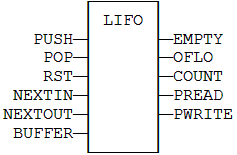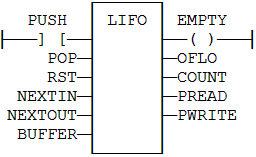![]()
 Function Block
Function Block![]() A function block groups an algorithm and a set of private data.
It has inputs and outputs. - Manages a last in / first out list.
A function block groups an algorithm and a set of private data.
It has inputs and outputs. - Manages a last in / first out list.
Inputs
|
Inputs |
Data Type |
Range |
Unit |
Default |
Description |
|---|---|---|---|---|---|
|
BUFFER |
ANY |
|
|
|
Array for storing values. |
|
NEXTOUT |
ANY |
|
|
|
Value at the top of the stack. Updated after call. |
|
NEXTIN |
ANY |
|
|
|
Value to be pushed. |
|
POP |
BOOL |
|
|
|
Pop a new value on the rising edge |
|
PUSH |
BOOL |
|
|
|
Push a new value on the rising edge. |
|
RST |
BOOL |
|
|
|
Reset |
Outputs
|
Outputs |
Data Type |
Range |
Unit |
Description |
|---|---|---|---|---|
|
EMPTY |
BOOL |
|
|
TRUE if the list is empty. |
|
OFLO |
BOOL |
|
|
TRUE if the overflow is on a PUSH command. |
|
DINT |
|
|
Number of values in the list. |
|
|
pRead |
DINT |
|
|
Index |
|
pWrite |
DINT |
|
|
Remarks
- NEXTIN, NEXTOUT, and BUFFER must have the same data type.
- It cannot be a STRING.
- The NEXTOUT argument specifies a variable filled with the value at the top of the stack after the block is called.
- Values are stored in the BUFFER array.
- Data is never shifted or reset.
- Only read and write pointers and pushed values are updated.
- The maximum size of the stack is the dimension of the array.
- The first time an instance of the LIFO function
 A function calculates a result according to the current value of its inputs.
A function has no internal data and is not linked to declared instances. block is called, that instance stores which array is passed to BUFFER.
A function calculates a result according to the current value of its inputs.
A function has no internal data and is not linked to declared instances. block is called, that instance stores which array is passed to BUFFER. - If a later call to the same instance passes a different array for the BUFFER argument, the call is considered invalid and no action is performed.
- The EMPTY output returns TRUE in this case.
FBD Language Example

FFLD Language Example
- In the FFLD Language, the input rung is the PUSH input.
- The output rung is the EMPTY output.

IL Language Example
(* MyLIFO is a declared instance of LIFO function block *)
Op1: CAL MyLIFO (PUSH, POP, RST, NEXTIN, NEXTOUT, BUFFER)
FFLD MyLIFO.EMPTY
STStructured text - A high-level language that is block structured and syntactically resembles Pascal. EMPTY
FFLD MyLIFO.OFLO
ST OFLO
FFLD MyLIFO.COUNT
ST COUNT
FFLD MyLIFO.PREAD
ST PREAD
FFLD MyLIFO.PWRITE
ST PWRITE
ST Language Example
(* MyLIFO is a declared instance of LIFO function block. *)
MyLIFO (PUSH, POP, RST, NEXTIN, NEXTOUT, BUFFER);
EMPTY := MyLIFO.EMPTY;
OFLO := MyLIFO.OFLO;
COUNT := MyLIFO.COUNT;
PREAD := MyLIFO.PREAD;
PWRITE := MyLIFO.PWRITE;
See Also






